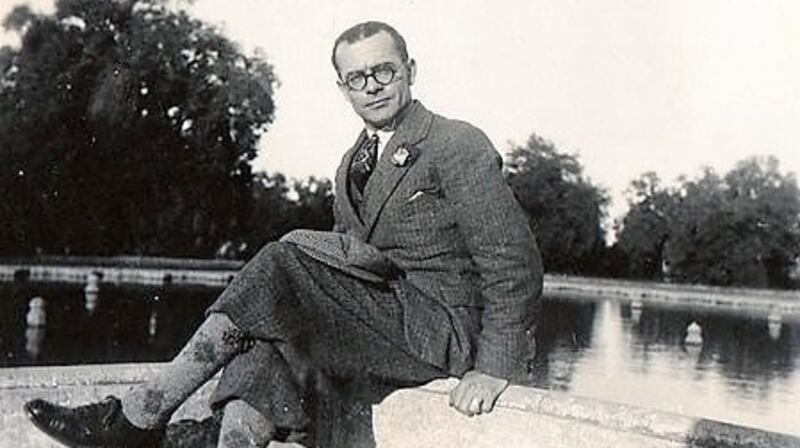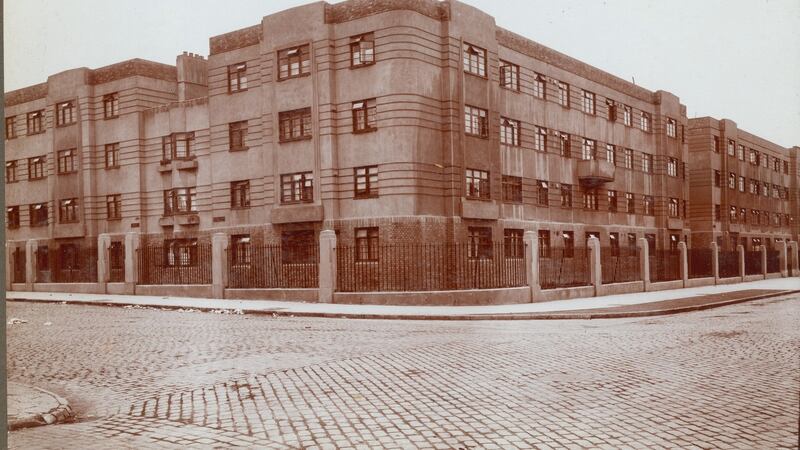In these lockdown nights of a silent pandemic, at Halloween when the dead supposedly walk in remnants of shrouds and of winding sheets, I find myself alone, opposite your former house.
Tonight not even living children have come forth to race beneath mature trees on St Mobhi Road, screaming behind their masks and feigning fright at the sight of fake skeletal hands reaching up from the lawns of these desirable 1930s properties, bedecked in the mock paraphernalia of horror.
But even if the ghosts of every former resident of this street were to crowd onto the pavement to re-enact daily rituals from past existences, I doubt if I would spot your unobtrusive presence among the throng. You were always so overlooked that it took hours before anyone found your body lying on dark train tracks, alive but so mutilated that they had to amputate your arm when trying to save you.


You stamped an indelible imprint on Dublin city, but are rarely remembered on this or any street. So allow me to pause a moment outside the door you departed from on your final morning alive, burdened by so much unfinished work to be done, so many dwellings to design, yet acutely aware that they would never be enough to house the poor and ease Dublin’s relentlessly unsolvable problems.
The weight of this responsibility besieges your mind, along with your own ghosts. Skeletal arms reach up from the mud of no-man’s-land, trying to grab you, furious at the unfairness of how a train driver’s son had used his ex-serviceman’s grant to study architecture, while their mutilated corpses still lie there, unfound.
You were the sole working-class diploma student in that university class, permitted to mix with social betters because you’d seen shell-shocked boys screaming, with amputated limbs. You became a true rarity, an architect who understood the reality, rather than the theory, of cramped housing, of shared outdoor toilets, of stampeding famished boys cascading down bare staircases in tenement buildings. Nothing was theoretical for you in conferences to plan layout densities of estates in Cabra West or Crumlin; Cumberland Street flats with their penny-dinner hall; the four-storey blocks in Cook Street with hipped roofs, where parapets and balconies garlanded the courtyard.
Councillors always denouncing any unenumerated cost. Cartels of sub-contractors conspiring to keep bids high; rings of timber merchants; coteries of cement importers. The chief city architect never replaced after he retired because the Corporation had you, a useful pack mule, to ply with additional work. Seventeen thousand dwellings designed and built in 16 years, 17,000 working-class families given turn-key homes with designs influenced by radical public-housing trends in Rotterdam.

Yet still you could never garner sufficient political backing to alleviate the slum conditions witnessed on your commute from this modernist St Mobhi Road house build by Linzell – a speculator as shrewd as his in-law, Alexander Strain. These builders prospered by focusing on the social caste who could afford the prestigious cachet of stained glass and bay windows that showcased parlours kept for visitors.
During their annual smoking dinners in the Dolphin Hotel, I wonder what such esteemed pillars of the Association of Dublin Housebuilders made of you, crippled by stress at trying to build your parallel city for the dispossessed? A foreigner in a city so scared of innovation or dissent that this street you lived on underwent a name change amid protests after initial plans for it to be called after a Protestant in Dean Swift. It is unsurprising that no plaque here bears your name that few remember. Our public acts of remembrance rarely commemorate workaday citizens who construct tangible legacies measureable in bricks and lime mortar.
So let me recall the last morning you opened this gate, the explanatory note already folded in your pocket. You cast a last look at St Mobhi Road before driving across this city you did more to shape than anyone in your time. Your mind plagued by all the tasks still to be done: delays on designated sites needing to be built on, families on waiting lists desperate for new homes. Harassed faces of your depleted, overwhelmed staff; vacancies left unfilled; innumerable sets of plans constantly seeming to multiply, piled on your desk.
Paymasters had blocked your plans to build more inner-city blocks of flats that families from adjacent tenements could be decanted into, leaving communities intact. No more curved angles or such expressionist finesse as befitted Corporation flats named after a countess. No more oversailing eaves in the art deco complexes you used to fantasise about, when sharing a bed with four brothers. Instead councillors insatiably demand the quick fix of soulless sprawls of cheaply prefabricated estates.

As you drive, you recall awaiting a whistle in a trench; three decades later, those blasts of bombs still resonate. Memories get muddled: amid the dead of no-man’s-land you see a guard signal to your father to release the brake of his huge hissing train, besieged by steam and smoke on your ninth birthday, when he let you ride in his cab; the stoker shovelling coal as if that heaving locomotive was a beast needing to be fed. This was the life you might have led if you had not endured a war that seems unmentionable in Dublin, which left you scarred by horrors never revealed to anyone.
Trying to shake those wartime blasts from your head, you recall your father, one night during your boyhood, describe the damp misery of his first job as a shepherd. You remember the sneers of fellow university students at your single pair of dilapidated boots worn for three years. You feel guilty about the letters needing urgent replies in the office you drive past on route to Dún Laoghaire. There, you wander amid crowds, a condemned man on day release, knowing the cell door will slam again; knowing that if you fight for 16 more years to erect thousands of new homes, it still wouldn’t be enough.
It has been four weeks now since you properly slept, the black dog at your shoulder refusing any respite, the beast who padded at your heels into an asylum and pretended to retreat when fended off by tablets that you ceased taking when they interfered with your work.
But this morning you had finally ordered your thoughts on paper, set out the helpless position, the impossible weight, as clearly as in the days when, as a young draftsman, you crafted every detail of your first architectural plan, discovering how a sanctuary existed in the parameters of blank sheets where you felt indubitably in command of the perspective, making every angle and aspect clear. “I cannot stand it any longer, my brain is too tired to work. It has not had a rest for twenty years except in heavy sleep. Always on the go like a dynamo and still work is piled on me. I am sorry to cause bother but think I am going slowly mad.”

You read your last written words again, seated alone in your car as dusk obscures the train tracks at Coal Quay Bridge. Whiskey sours your stomach, but you take a final swig before opening the car door to walk over and observe the neat symmetry of sleepers laid by railway workers. Studying the lights of the ongoing train, you suddenly feel like a boy again, waiting for your father to come, driving his engine, the carriages filled with fallen men, at top speed in his haste to get home to Kentish Town. Patiently you await him by that unlit stretch of track, choosing your moment to step forth into the unknown.
Every night during the pandemic lockdown, the poet Dermot Bolger set out to walk deserted Dublin streets, allowing his imagination free rein to speculatively meditate on the lives of often forgotten figures who once populated those same streets. Bolger's poems and meditations are published in a new book, Other People's Lives (New Island €12.95). This meditation is written in memory of the great public housing architect, Herbert Simms, who worked tirelessly to try and solve Dublin's chronic housing problems in the 1930s and 1940s, before he took his own life, overwhelmed by the task.
[ Remembering Herbert Simms, the man who rebuilt DublinOpens in new window ]











